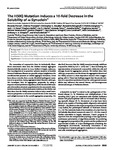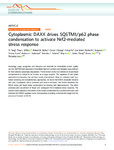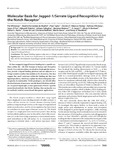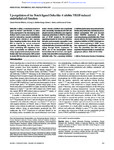The H50Q Mutation Induces a 10-fold Decrease in the Solubility of α-Synuclein

Date
2015-01Author
Subject
Metadata
Show full item recordAbstract
The conversion of α-synuclein from its intrinsically disordered monomeric state into the fibrillar cross-β aggregates characteristically present in Lewy bodies is largely unknown. The investigation of α-synuclein variants causative of familial forms of Parkinson disease can provide unique insights into the conditions that promote or inhibit aggregate formation. It has been shown recently that a newly identified pathogenic mutation of α-synuclein, H50Q, aggregates faster than the wild-type. We investigate here its aggregation propensity by using a sequence-based prediction algorithm, NMR chemical shift analysis of secondary structure populations in the monomeric state, and determination of thermodynamic stability of the fibrils. Our data show that the H50Q mutation induces only a small increment in polyproline II structure around the site of the mutation and a slight increase in the overall aggregation propensity. We also find, however, that the H50Q mutation strongly stabilizes α-synuclein fibrils by 5.0 ± 1.0 kJ mol(-1), thus increasing the supersaturation of monomeric α-synuclein within the cell, and strongly favors its aggregation process. We further show that wild-type α-synuclein can decelerate the aggregation kinetics of the H50Q variant in a dose-dependent manner when coaggregating with it. These last findings suggest that the precise balance of α-synuclein synthesized from the wild-type and mutant alleles may influence the natural history and heterogeneous clinical phenotype of Parkinson disease.
Collections
Publisher
Place of Publication
Journal
Volume
Issue
Pagination
Recommended, similar items
The following license files are associated with this item:
Related items
Showing items related by title, author, creator and subject.
-
Cytoplasmic DAXX drives SQSTM1/p62 phase condensation to activate Nrf2-mediated stress response
Yang, Y; Willis, TL; Button, RW; Strang, CJ; Fu, Y; Wen, X; Grayson, PRC; Evans, T; Sipthorpe, RJ; Roberts, SL; Hu, Bing; Zhang, J; Lu, B; Luo, Shouqing (Springer Science and Business Media LLCEngland, 2019-08-21)<jats:title>Abstract</jats:title><jats:p>Autophagy cargo recognition and clearance are essential for intracellular protein quality control. SQSTM1/p62 sequesters intracellular aberrant proteins and mediates cargo delivery ... -
Molecular basis for Jagged-1/Serrate ligand recognition by the Notch receptor.
Whiteman, P; de Madrid, BH; Taylor, P; Li, D; Heslop, R; Viticheep, N; Tan, JZ; Shimizu, H; Callaghan, J; Masiero, M; Li, JL; Banham, AH; Harris, AL; Lea, SM; Redfield, C; Baron, M; Handford, PA (United States, 2013-03-08)We have mapped a Jagged/Serrate-binding site to specific residues within the 12th EGF domain of human and Drosophila Notch. Two critical residues, involved in a hydrophobic interaction, provide a ligand-binding platform ... -
Up-regulation of the Notch ligand Delta-like 4 inhibits VEGF-induced endothelial cell function.
Williams, CK; Li, J-L; Murga, M; Harris, AL; Tosato, G (United States, 2006-02-01)Delta-like 4 (Dll4), a membrane-bound ligand for Notch1 and Notch4, is selectively expressed in the developing endothelium and in some tumor endothelium, and it is induced by vascular endothelial growth factor (VEGF)-A ...





